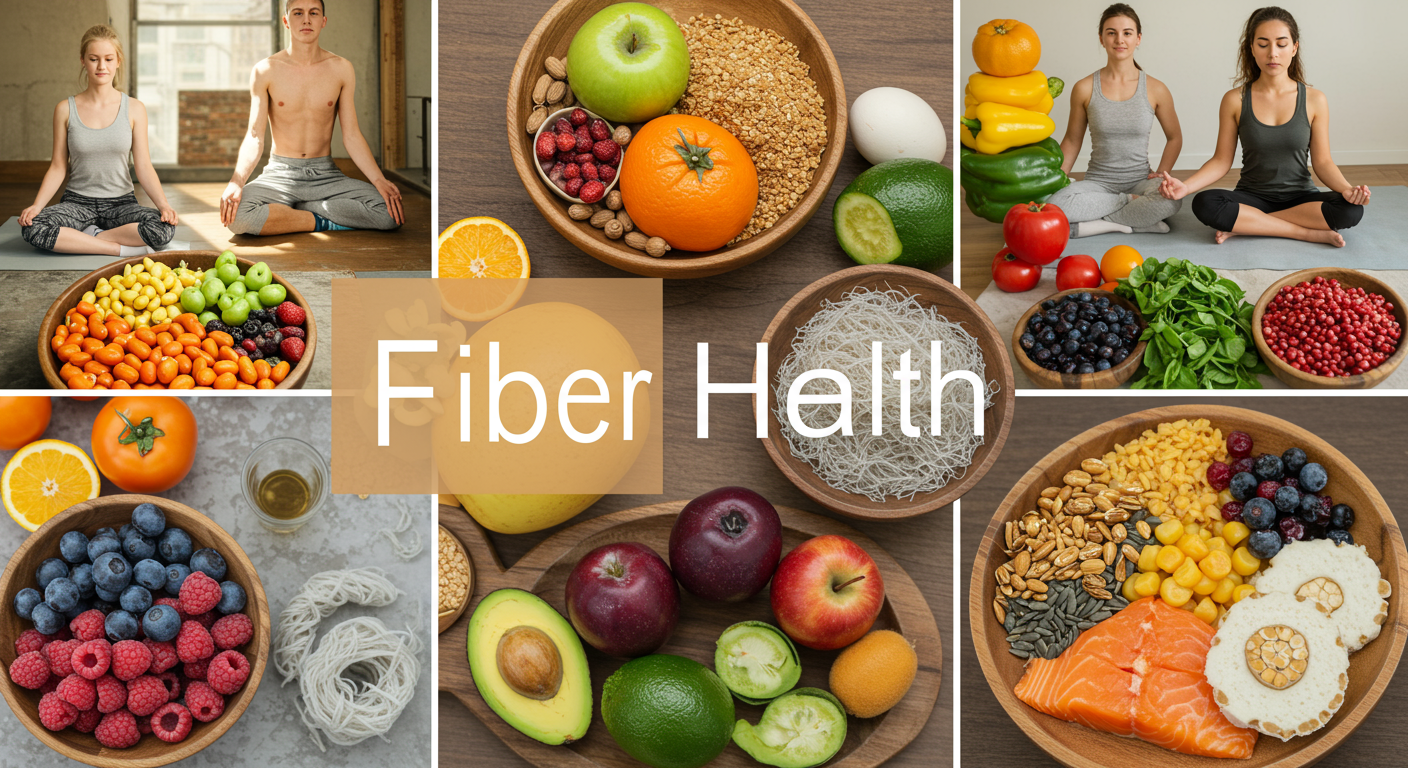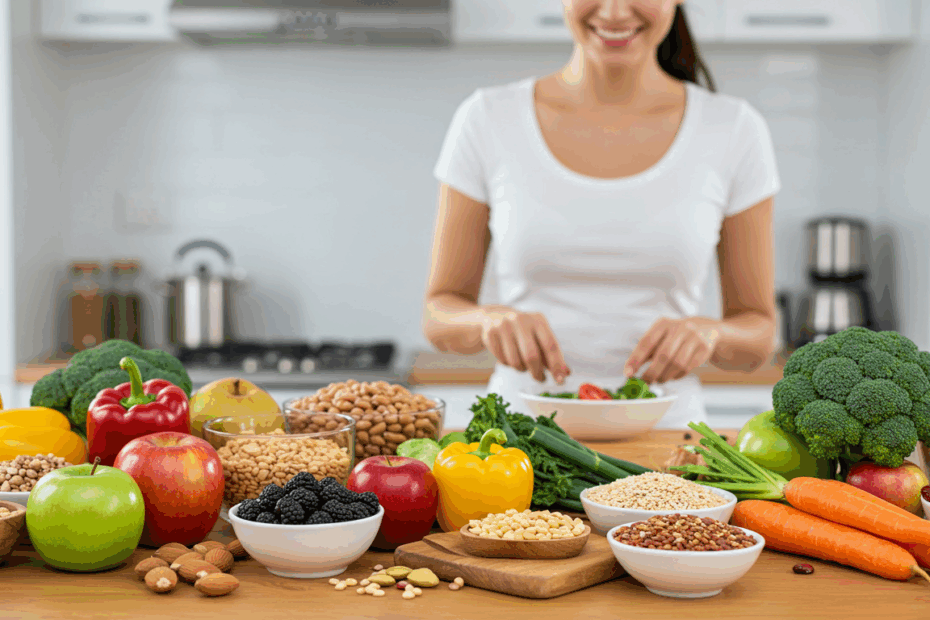Lila: John, have you noticed the surge in conversation around a new lifestyle trend? I keep seeing the term “Fiber, Health” and even something called “fibermaxxing” popping up in my feeds. It sounds intense, but also… foundational. What’s the real story here? Is this just another fleeting wellness fad?
John: That’s a great question, Lila. It’s interesting to see old wisdom repackaged for a new generation. The “Fiber, Health” lifestyle isn’t so much a new trend as it is a renewed, more intentional focus on a cornerstone of nutrition that we’ve frankly been neglecting for decades. Think of it less as a fad and more as a course correction. For years, diet culture has been about restriction—cutting carbs, cutting fats. This is about addition. It’s about actively ensuring you get enough of one of the most powerful nutrients for your body: dietary fiber.
Lila: A course correction, I like that. It feels less intimidating. So, before we get into the “maxxing” part, can we start with the basics? When we say fiber, what are we actually talking about? I know it’s in fruits and vegetables, but the concept itself feels a bit abstract. Is it just… roughage?
John: Exactly. The term “roughage” is a bit dated, but it points in the right direction. Scientifically, dietary fiber is a type of carbohydrate that your body can’t digest or absorb. Unlike other carbs, which are broken down into sugar molecules, fiber passes relatively intact through your stomach, small intestine, and colon, and out of your body. This journey, however, is anything but passive. It’s where all the magic happens. The core idea of the “Fiber, Health” lifestyle is to consciously harness that magic for profound, long-term health benefits.
Lila: Okay, so it’s the indigestible part of plant foods. But if we can’t digest it, how can it be so good for us? That’s the part I think most people get stuck on. It seems counterintuitive.
John: It does, but that’s the beautiful paradox of fiber. Its power lies precisely in its indigestibility. It plays multiple, crucial roles as it moves through our system. We can broadly categorize fiber into two main types, soluble and insoluble, and each has its own unique set of jobs that contribute to our overall well-being. This distinction is fundamental to understanding why eating a diet filled with fiber is a great way to support your digestive system and so much more.
Lila: Soluble and insoluble. Right. I remember hearing about that in a nutrition class. One dissolves in water and the other doesn’t? Can you break that down for us? What does each one actually do inside our bodies?
John: You’ve got it. Soluble fiber dissolves in water to form a gel-like substance in your digestive tract. Think of what happens when you add water to oatmeal or chia seeds—that’s soluble fiber at work. This gel has several remarkable effects. It slows down digestion, which helps you feel fuller for longer and plays a vital role in balancing blood sugar. It also acts like a sponge, binding to cholesterol and escorting it out of the body, which is fantastic for heart health. This is the type of fiber that directly helps in lowering cholesterol levels.
Lila: A gel that makes you feel full and cleans out cholesterol… that’s a powerful image. What about the other kind, insoluble fiber?
John: Insoluble fiber is what people traditionally think of as “roughage.” As its name suggests, it does not dissolve in water. Instead, it adds bulk to your stool. Think of it as a sort of intestinal broom. This bulk helps to keep things moving along, promoting regularity and preventing constipation. If you’re struggling with normalizing bowel movements, insoluble fiber is your best friend. It’s essential for maintaining bowel health and a healthy, regular digestive rhythm.

Lila: Okay, that makes perfect sense. So, we need both the “gel” and the “broom.” It sounds like the first major benefit, and the one most people associate with fiber, is digestive health. You mentioned it helps with normalizing bowel movements and preventing constipation. This seems to be a huge selling point for many people.
John: It absolutely is, and for good reason. It’s the most immediate and tangible effect people often feel when they increase their fiber intake. Constipation is incredibly common, and often, it’s a direct result of a low-fiber diet. By adding that bulk from insoluble fiber and drawing water into the colon, you make stools softer and easier to pass. This isn’t just about comfort; it’s about health. Regular bowel movements are crucial for eliminating waste and toxins from your body efficiently. Maintaining bowel health is a foundational step to overall wellness.
Lila: But it goes deeper than just that, right? I’ve seen articles, like one from AdventHealth, calling fiber a “Gut Health Hero.” They talk about the microbiome. This is where it gets really interesting for me. It’s not just about pushing things through; it’s about what we leave behind.
John: Precisely, Lila. This is where we move from basic mechanics to advanced biology, and it’s arguably the most exciting area of fiber research. Our gut is home to trillions of microorganisms—bacteria, fungi, and viruses—collectively known as the gut microbiome. Think of it as a complex, living ecosystem inside you. For this ecosystem to be healthy, you need a diverse and thriving population of “good” bacteria.
Lila: And let me guess, fiber is what they eat?
John: You’re exactly right. Fiber, particularly the soluble kind, is a prebiotic. It acts as food for these beneficial gut bacteria. When these bacteria ferment fiber, they produce compounds called short-chain fatty acids (SCFAs), like butyrate. These SCFAs are metabolic gold. They are the main source of energy for the cells lining your colon, they help reduce inflammation throughout the body, and they even play a role in strengthening the gut barrier, which prevents harmful substances from leaking into your bloodstream. So, in a very real sense, fiber feeds the good bacteria in your gut, which in turn, helps take care of you.
Lila: Wow. So it’s not just about our health, but the health of the trillions of tiny organisms living inside us. It’s like we’re tending to an internal garden. That’s a much more compelling reason to eat my veggies! The SERP results I pulled mentioned that a healthy gut promotes better digestion, reduced inflammation, and improved immunity. It’s all connected.
John: It’s profoundly interconnected. That inflammation-reducing effect of SCFAs is key. Chronic, low-grade inflammation is linked to nearly every major modern disease, from heart disease to diabetes and even certain cancers. By nourishing your gut microbiome with fiber, you’re creating an anti-inflammatory internal environment. And since a large portion of our immune system is located in the gut, a healthy microbiome means a more robust and well-regulated immune response. It’s a clear example of how fiber is good for both your digestion and overall health.
Lila: Okay, so we have digestive regularity and a flourishing gut microbiome. What else is on this list of benefits? I saw a GoodRx article that mentioned balancing blood sugar and lowering cholesterol. You touched on that with soluble fiber.
John: Yes, and it’s worth diving deeper into. Let’s start with blood sugar. When you eat a meal high in refined carbohydrates and low in fiber, those carbs are broken down quickly, causing a rapid spike in your blood sugar. Your pancreas then releases a surge of insulin to manage it. Over time, these spikes and crashes can lead to insulin resistance and type 2 diabetes. Soluble fiber is the antidote. By forming that gel, it slows the absorption of sugar into the bloodstream, leading to a more gradual, stable rise and fall. This is crucial for both preventing and managing diabetes.
Lila: So, eating an apple is much better than drinking apple juice because the fiber in the whole fruit prevents that sugar rush?
John: An excellent and practical example. The fiber in the whole apple acts as a built-in buffer. The juice, stripped of its fiber, is just a shot of sugar. This principle applies across the board. Choosing whole grains over white flour, whole fruits over juices—these choices have a massive impact on your metabolic health, all thanks to fiber.
Lila: And the cholesterol connection? You said it acts like a sponge.
John: It does. The gel from soluble fiber can bind with cholesterol and bile acids (which are made from cholesterol) in the small intestine. Instead of being reabsorbed into the body, they get carried out with the waste. Your liver then has to pull more cholesterol from your blood to make new bile acids, which effectively lowers your overall LDL, or “bad,” cholesterol levels. It’s a simple, elegant mechanism with a powerful, protective effect on your cardiovascular system.
Lila: Which leads directly to another major benefit I’ve seen mentioned in multiple sources, including The Washington Post: a lower risk of heart disease. It’s not just about cholesterol, is it? I saw a GQ article that also linked high-fiber diets to lower blood pressure and inflammation.
John: Correct. It’s a multi-pronged attack on heart disease risk. You have the direct cholesterol-lowering effect we just discussed. Then you have the indirect benefits. By improving blood sugar control, you reduce damage to your blood vessels. By lowering chronic inflammation, you protect the entire cardiovascular system. And yes, studies have shown that high-fiber diets are associated with lower blood pressure. When you combine all these factors, it’s clear why studies have shown that a high-fiber diet can lower the risk of heart disease and improve longevity.
Lila: You mentioned longevity and cancer risk. That sounds incredibly significant. What’s the evidence there?
John: The evidence is very strong, particularly for colorectal cancer. The mechanisms are thought to be threefold. First, by increasing stool bulk and promoting regularity, fiber dilutes potential carcinogens and speeds up the time it takes for them to pass through the colon, reducing their contact with the colon wall. Second, the fermentation of fiber into those beneficial SCFAs, especially butyrate, provides energy to colon cells and has been shown to inhibit the growth of tumor cells. And third, the overall anti-inflammatory effect of a healthy gut microbiome creates a less hospitable environment for cancer to develop. It’s a powerful combination of protective factors.

Lila: That is incredible. We’ve covered digestion, gut health, blood sugar, cholesterol, heart disease, and now cancer risk. It feels like fiber is this master key to unlocking better health. No wonder people are getting so serious about it they’re calling it “fibermaxxing.” So, this brings us to the “how.” How much do we actually need, and where do we get it from?
John: This is the practical side, and it’s where the “Fiber, Health” lifestyle becomes a daily practice. The general recommendations, as noted in sources like Women’s Health, are for adults to aim for 25 to 38 grams of fiber per day. Women are typically advised to get around 25 grams, and men around 38 grams. To put that in perspective, most adults in Western countries get less than half of that—often only 15 grams a day.
Lila: Only 15 grams? That’s a huge gap. It’s no wonder so many of us are dealing with the health issues we just talked about. So, if we want to close that gap, what should we be putting on our plates? A Verywell Health article broke it down into five main groups: fruits, vegetables, legumes, nuts and seeds, and grains.
John: That’s the perfect framework. The key to a successful high-fiber diet isn’t just quantity, but also diversity. Getting fiber from all those different groups ensures you’re getting a mix of soluble and insoluble types, plus all the different vitamins, minerals, and phytonutrients that come with them. Let’s break them down.
Lila: Let’s start with fruit. It’s probably the easiest and most delicious entry point for a lot of people. Which ones are the champions of fiber?
John: Fruits are fantastic sources, especially those with edible skins and seeds. Berries are superstars. Raspberries, for instance, are exceptionally high in fiber, with about 8 grams per cup. Pears, with the skin on, are another great choice. Apples, bananas, oranges, and strawberries are all solid contributors. And one that might surprise people is the avocado. It’s technically a fruit and is loaded with fiber—about 10 grams in a medium-sized one—along with healthy fats.
Lila: I saw avocados on a dietitian’s grocery list from Health.com! I’m glad they count. Okay, what about vegetables? I assume the greener and leafier, the better?
John: That’s a good rule of thumb, but it’s broader than that. Cruciferous vegetables like broccoli and Brussels sprouts are packed with fiber. Root vegetables like carrots and beets are great. Artichokes are one of the highest-fiber vegetables you can find. Even a simple baked potato, with the skin, provides a decent amount. The goal is to “eat the rainbow,” as they say, to get a wide variety of nutrients alongside the fiber.
Lila: Next on the list are legumes. This category feels like a secret weapon. They’re cheap, versatile, and from what I understand, incredibly dense in fiber and protein.
John: They are an absolute powerhouse. Legumes—which include beans, lentils, chickpeas, and peas—are some of the most fiber-rich foods on the planet. A single cup of cooked lentils can provide over 15 grams of fiber, which is more than half the daily recommendation for some people. The same goes for black beans, kidney beans, and chickpeas. Incorporating them into soups, salads, or making things like hummus is an incredibly efficient way to boost your intake.
Lila: I can see how adding a cup of lentils to a soup could make a huge difference. Okay, what about nuts and seeds? I see chia seeds and flax seeds mentioned everywhere.
John: Nuts and seeds are small but mighty. Almonds, pistachios, and walnuts are all good sources of fiber. But the real standouts are the seeds. Chia seeds are phenomenal; just two tablespoons contain about 10 grams of fiber, mostly soluble. They form that gel we talked about, making them great for puddings or as an addition to oatmeal. Flax seeds are another excellent source. You just need to make sure you consume them ground, as your body can’t break down the whole seeds to get to the nutrients inside.
Lila: That’s a great practical tip. Finally, we have grains. For a long time, carbs and grains were villainized. How do we choose the right ones for a fiber-rich diet?
John: The key word is “whole.” Whole grains contain the entire grain kernel—the bran, germ, and endosperm. The fiber is concentrated in the bran. Refined grains, like white bread and white rice, have had the bran and germ removed, stripping them of their fiber and most of their nutrients. So, the “Fiber, Health” approach means choosing 100% whole wheat bread, brown rice, barley, and especially things like quinoa and oats. Oatmeal is a classic high-fiber breakfast for a reason; it’s full of a specific type of soluble fiber called beta-glucan, which is particularly effective at lowering cholesterol.
Lila: This is a fantastic list. It feels very achievable. So, let’s get into the practical application. I see the term “fibermaxxing,” which sounds like you go from zero to a hundred. Is that wise? Or is there a better way to start incorporating all these foods?
John: That’s a critical point, Lila. “Fibermaxxing” as a concept—aiming to meet or exceed your daily fiber needs—is great. But the execution needs to be strategic. You absolutely should not go from 15 grams a day to 40 grams a day overnight. Your digestive system, and specifically your gut microbiome, needs time to adapt. A sudden, massive increase in fiber can lead to uncomfortable side effects like gas, bloating, and cramping as your gut bacteria have a massive feast they’re not used to.
Lila: So, what’s the smart approach? How do you ease into it?
John: The golden rule is “go slow and steady.” Start by adding one high-fiber serving per day for a week. Maybe it’s switching your white toast for oatmeal at breakfast. Or adding a handful of berries to your yogurt. The following week, add another serving—perhaps a side of black beans with your lunch. Increase your intake by about 5 grams every few days, giving your body time to adjust. This gradual approach minimizes potential discomfort.
Lila: And I’ve read that water is extremely important when you’re upping your fiber. Why is that?
John: It’s non-negotiable. Remember how fiber works: soluble fiber forms a gel with water, and insoluble fiber adds bulk that absorbs water. If you increase your fiber intake without also increasing your fluid intake, you can actually make constipation worse. The fiber can become a dense, hard mass in your gut. So, as you add more fiber to your diet, you must also drink more water throughout the day. They work as a team.
Lila: That makes perfect sense. Could we sketch out what a high-fiber day might look like? The Washington Post article had a meal plan from a gastroenterologist. Maybe we could create a simple, beginner-friendly version to give people a concrete example.
John: An excellent idea. Let’s build a sample day that aims for around 30-35 grams of fiber, using the foods we’ve discussed.
For **Breakfast**, you could have a bowl of oatmeal (about 4g of fiber) topped with a tablespoon of chia seeds (5g) and a cup of raspberries (8g). Right there, you’re already at 17 grams of fiber before you’ve even really started your day.
For **Lunch**, a large salad with mixed greens, lots of colorful vegetables, and a cup of chickpeas (about 12g) would be a great choice. Use a simple vinaigrette dressing.
For a **Snack** in the afternoon, an apple with the skin on (4.5g) and a small handful of almonds (3.5g) would be perfect.
And for **Dinner**, you could have a piece of baked salmon with a side of quinoa (about 5g per cup) and a generous serving of steamed broccoli (5g per cup).
If you add that all up, you’re well over 50 grams, which shows how achievable it is. A beginner could start with just one of these meals and build from there.
Lila: Seeing it laid out like that makes it seem so much less daunting. It’s not about eating weird, special foods. It’s about choosing nutrient-dense, whole foods that are readily available. It’s about swaps: whole-wheat pasta instead of white, brown rice instead of white, adding a can of lentils to your spaghetti sauce.
John: Exactly. Those simple swaps are the foundation of a sustainable “Fiber, Health” lifestyle. Every choice is an opportunity. Snacking on dates, as a dietitian from Health.com suggested, instead of candy. Adding frozen raspberries to a smoothie. Choosing an avocado for your toast. These small hinges swing big doors when it comes to your health.

Lila: I love that. “Small hinges swing big doors.” It feels very empowering. So, to wrap this up, what’s the big-picture takeaway for someone who’s just learning about this? What’s the one thing we want them to remember?
John: The most important takeaway is that fiber isn’t just about digestion. It is a fundamental, non-negotiable component of a diet that promotes long-term, holistic health. It feeds your gut, protects your heart, balances your metabolism, and may even extend your life. Focusing on fiber is one of the most powerful and evidence-based actions you can take to reclaim control over your well-being. It’s not a quick fix or a hack; it’s a lifelong partnership with your body.
Lila: And from my perspective, I’d add that it doesn’t have to be complicated or perfect. You don’t need to count every single gram at the start. Just begin by asking yourself at each meal, “Where’s the fiber?” Can I add a fruit, a vegetable, a handful of nuts? It’s a journey of addition, not subtraction. It’s about nourishing your body and the vast, complex world within it. The “Fiber, Health” lifestyle is ultimately about choosing to thrive, one colorful, delicious, fiber-rich meal at a time.
John: Well said, Lila. It’s about recognizing that what we eat has a profound ripple effect. By focusing on this one simple, yet powerful, nutrient, we are making a significant investment in our present and future health. And that’s a trend worth embracing.
